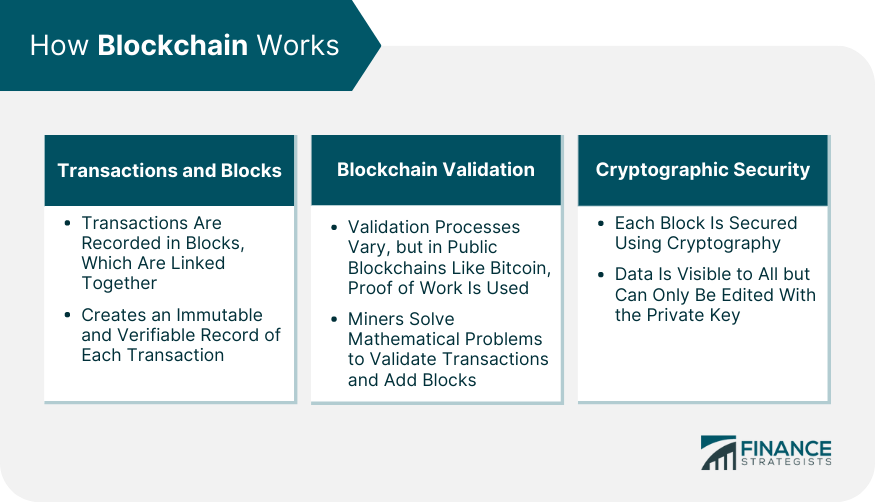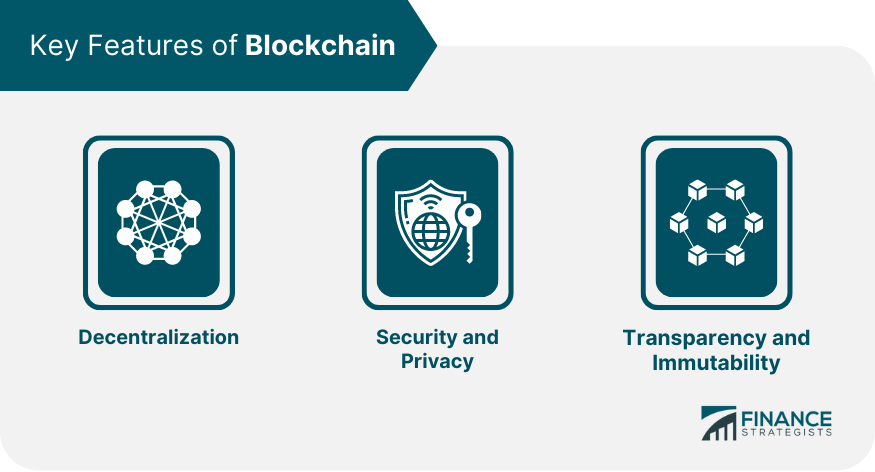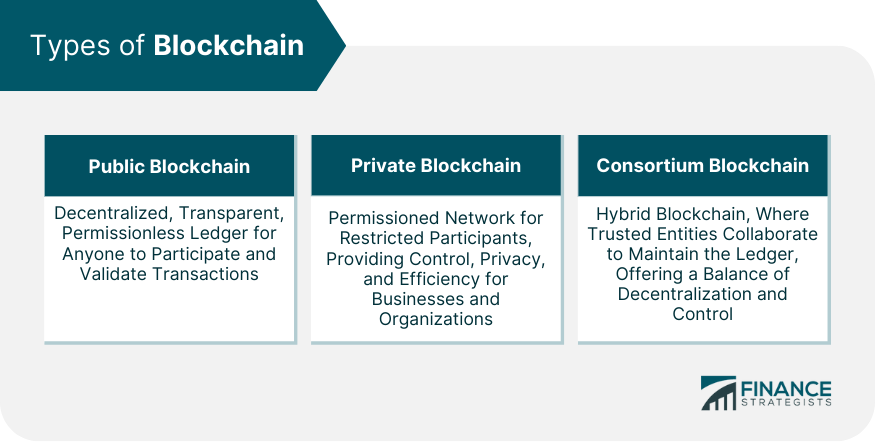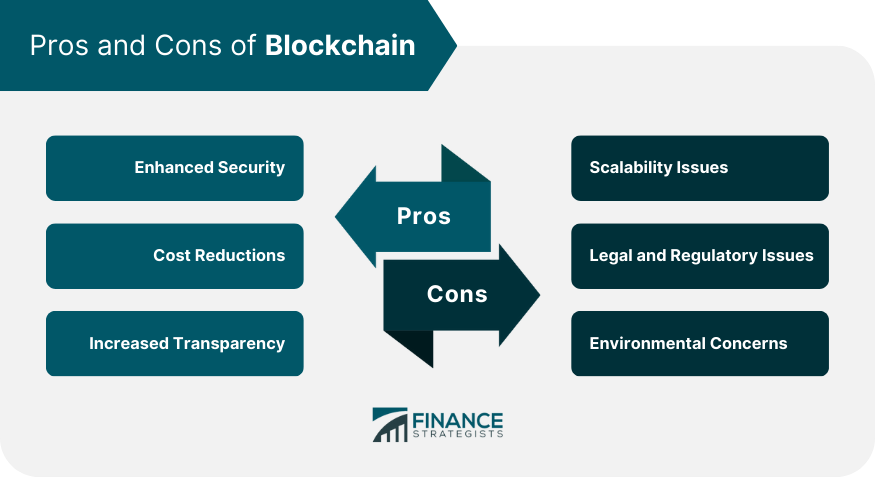Blockchain is a revolutionary technology, essentially a decentralized digital ledger, which records transactions across many computers in a way that the registered data cannot be altered retroactively. The main purpose of blockchain is to allow fast, secure, and transparent peer-to-peer transactions. It provides enhanced security, transparency, and efficiency in data exchange, transforming various industries from finance to healthcare. The concept of a decentralized system dates back to the late 20th century as part of the cypherpunk movement, but the modern blockchain was proposed in 2008 by an anonymous entity called Satoshi Nakamoto, primarily to support Bitcoin, the pioneering cryptocurrency. Since then, the technology has evolved tremendously, and its applications have extended far beyond cryptocurrencies, exploring promising potentials in diverse sectors. Blockchain operates by recording a series of transactions in blocks, with each block linked to the one before it. This creates an immutable and verifiable record of each transaction. Each transaction in a block is a record of an event. For example, in the context of cryptocurrencies like Bitcoin, this would be a record of money changing hands. Once each transaction is verified, it's added to a block. Once a block is full of transactions, it's time for the validation process. This process varies depending on the type of blockchain. In a public blockchain like Bitcoin, the validation process involves a mechanism known as proof of work, where miners solve complex mathematical problems to validate the transactions and add the block to the chain. Each block is secured using cryptographic principles. This means the data inside a block can be seen by everyone, but it can only be edited by the holder of the private key. Blockchain offers unique advantages that have the potential to revolutionize various industries. Unlike traditional databases, blockchain isn't stored in a single location or managed by a single entity. Instead, it's distributed across a network of computers or nodes, making it truly decentralized. Blockchain’s design makes it inherently secure. Because it's decentralized, it doesn't have a single point of failure. Each transaction is transparent and can be tracked, yet the identity of the parties involved remains private. All transaction data on the blockchain is publicly visible and immutable, meaning it cannot be changed or deleted. Blockchains can be classified into three types based on the access permissions held by participants: public, private, and consortium blockchains. A public blockchain is a decentralized ledger where anyone can participate, validate transactions, and maintain the network. It offers a high level of transparency, as all transactions are visible to the public. Public blockchains, like Bitcoin and Ethereum, rely on consensus algorithms to reach an agreement on the validity of transactions. They are open to anyone, allowing for a permissionless and inclusive network. Unlike public blockchains, private blockchains are restricted networks that require permission for access and participation, limiting it to a specific group of participants. Private blockchains are often used by businesses and organizations that require greater control over their data and operations. They provide privacy and restrict the ability to participate in the network, usually through a centralized authority or a consortium of trusted entities. Private blockchains are suited for use cases where participants need to maintain strict control over their data and ensure a higher level of efficiency. Consortium blockchains are a hybrid form that combines elements of both public and private blockchains. In a consortium blockchain, a group of organizations or entities come together to form a network where they collectively maintain the blockchain and make decisions regarding its governance. Consortium blockchains offer a balance between decentralization and control, as the participating entities are known and trusted, and consensus mechanisms can be tailored to their specific needs. This type of blockchain is often used in industries such as finance, supply chain management, or healthcare, where multiple stakeholders collaborate while maintaining some level of privacy and control. Blockchain's potential uses extend far beyond cryptocurrencies. Cryptocurrencies, often synonymous with blockchain, is its most recognized use case. This digital form of currency applies innovative technology to maintain a secure, decentralized log of all transactions. Bitcoin, the pioneer of cryptocurrencies, marked the debut of blockchain technology in 2008. Conceived by an unidentified individual or group known as Satoshi Nakamoto, Bitcoin applies blockchain to record all transactions, providing a public, tamper-proof ledger. In essence, each Bitcoin transaction is recorded on this blockchain, enhancing security and transparency. While Bitcoin introduced the world to blockchain, many other cryptocurrencies have emerged since, leveraging the technology in innovative ways. For instance, Ethereum, another popular cryptocurrency, built upon the blockchain framework by introducing smart contracts—automated contracts executed when specific conditions are met. On the other hand, Ripple, a unique cryptocurrency, applies blockchain technology to facilitate quick, inexpensive international monetary transfers. It highlights the blockchain's potential for not just recording transactions but also making the process more efficient and cost-effective. Blockchain technology carries immense potential to revolutionize the finance and banking industry. Its ability to provide a secure, decentralized ledger for transactions is disrupting traditional financial systems. The term 'Smart Contracts' is often associated with Ethereum. These are essentially automated contracts where the terms and conditions are pre-programmed. Once these conditions are met, the contract self-executes. This automation not only enhances efficiency but also minimizes the risk of manual errors and delays. Traditionally, these transactions have been slow, costly, and require multiple intermediaries. Blockchain transforms this process by offering a faster, more secure, and more cost-efficient alternative, eliminating the need for intermediaries and streamlining global payments. The versatility of blockchain extends beyond finance and banking. Various sectors, from healthcare to supply chain management, are leveraging this technology's benefits, paving the way for the widespread adoption of blockchain across numerous industries. Like any technology, blockchain has its pros and cons. Blockchain technology offers several key benefits. Enhanced Security: Blockchain's cryptographic security measures make it resistant to fraud and hacking. Cost Reductions: By eliminating the need for intermediaries, blockchain can reduce costs in many industries, especially finance and banking. Increased Transparency: With all transactions being added to a single public ledger, blockchain greatly increases transparency. Despite its pros, blockchain is not without its challenges and limitations. Scalability Issues: As the number of transactions increases, so does the size of the blockchain, leading to potential scalability issues. Legal and Regulatory Issues: The decentralized nature of blockchain presents new and complex legal and regulatory challenges that are yet to be fully addressed. Environmental Concerns: The mining process in a public blockchain like Bitcoin consumes a massive amount of energy, leading to environmental concerns. Blockchain technology has emerged as a revolutionary concept with the potential to transform various industries. It is a decentralized digital ledger that records transactions securely and transparently. Blockchain's key features, including decentralization, security, privacy, transparency, and immutability, make it a powerful tool for revolutionizing industries such as finance, banking, healthcare, and supply chain management. The technology has evolved beyond cryptocurrencies like Bitcoin and Ethereum, with emerging trends like DeFi, BaaS, and interoperability among blockchains shaping its future. However, blockchain also has its limitations, including scalability issues, legal and regulatory challenges, and environmental concerns. As the technology continues to advance, addressing these challenges will be crucial for wider adoption. Nevertheless, the potential benefits of enhanced security, cost reductions, and increased transparency make blockchain a promising technology with significant implications for the future.What Is a Blockchain?
How Blockchain Works
Transactions and Blocks
Blockchain Validation Process
Cryptographic Security Measures

Key Features of Blockchain
Decentralization
Security and Privacy
Transparency and Immutability

Types of Blockchain
Public Blockchain
Private Blockchain
Consortium Blockchain

Applications of Blockchain Technology
Blockchain's Role in Cryptocurrency
Connection Between Bitcoin and Blockchain
Expansion to Other Cryptocurrencies: Ethereum, Ripple, and Beyond
Blockchain's Influence on Finance and Banking
Smart Contracts
Cross-Border Payments
Blockchain's Impact Across Industries
Pros and Cons of Blockchain
Pros
Cons

Bottom Line
Blockchain FAQs
A Blockchain is a chain of digital blocks, each containing data, usually representing transactions. Each block is linked to the one before it, creating a secure, immutable record of transactions. Once data is recorded in a block, it's very difficult to change or remove. The validation process varies depending on the type of blockchain, with public blockchains often utilizing a system known as proof of work.
Blockchains can be classified into three types based on access permissions: Public, Private, and Consortium Blockchains. Public blockchains are open to anyone, private blockchains are restricted to a certain group of people or an organization, and consortium blockchains are semi-decentralized, where only a group of organizations can validate transactions.
Blockchain technology is famously used in cryptocurrencies like Bitcoin and Ethereum. However, its applications extend far beyond that. It's used in finance and banking for things like smart contracts and cross-border payments. Other industries, such as supply chain management, healthcare, real estate, and voting systems, are also exploring the use of blockchain.
Blockchain offers several advantages, like enhanced security, cost reductions, and increased transparency due to its decentralized nature and cryptographic security measures. However, it also presents challenges such as scalability issues, legal and regulatory complexities, and environmental concerns, particularly with energy-intensive mining processes in public blockchains like Bitcoin.
Blockchain achieves security through cryptographic principles, making data visible to everyone but editable only by the holder of the private key.
True Tamplin is a published author, public speaker, CEO of UpDigital, and founder of Finance Strategists.
True is a Certified Educator in Personal Finance (CEPF®), author of The Handy Financial Ratios Guide, a member of the Society for Advancing Business Editing and Writing, contributes to his financial education site, Finance Strategists, and has spoken to various financial communities such as the CFA Institute, as well as university students like his Alma mater, Biola University, where he received a bachelor of science in business and data analytics.
To learn more about True, visit his personal website or view his author profiles on Amazon, Nasdaq and Forbes.











